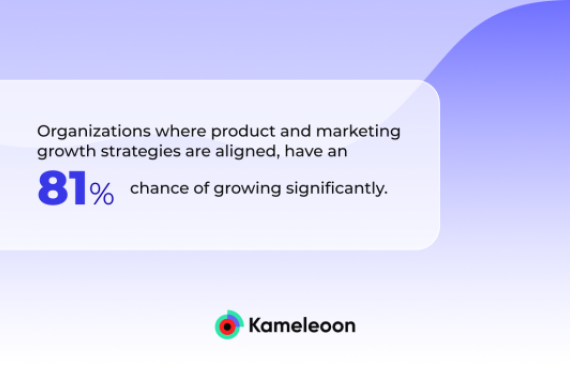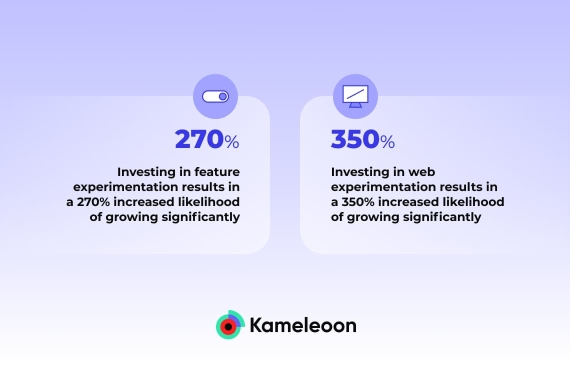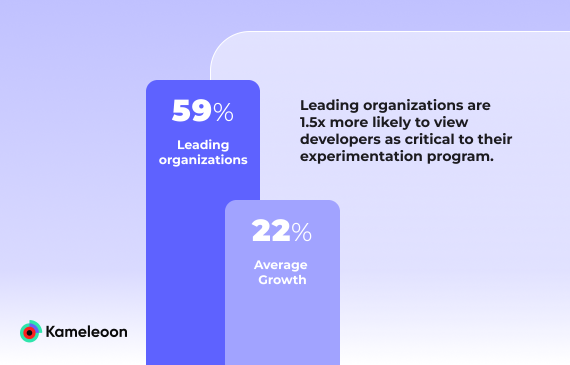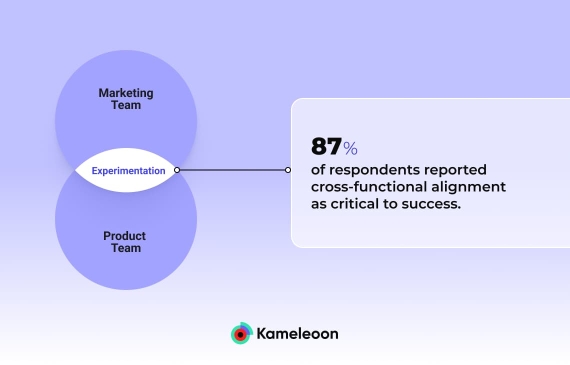
5 Key Factors Shared by High-Performing Organizations in Achieving Growth
Lessons learned from leading organizations in SaaS, healthcare, ecommerce, and more.
Gone are the days when companies had to decide between product and marketing-led growth strategies.
Today, nine out of ten top-performing companies take a combined product-led (PLG) and marketing-led (MLG) approach to achieve their growth goals.
To better understand how high-performing organizations approach growth, Kameleoon administered the 2023 Experimentation and Growth Survey to 159 department leaders across the USA and the UK.
According to the survey, the best companies have a deeply integrated experimentation strategy and opt for off-the-shelf and integrated experimentation technology to thrive in this competitive landscape.
In this article, we’ll explore the five common elements of high-performing organizations when it comes to growth and experimentation. By understanding these factors, your company can enhance its performance and strive for even greater success.
1 They align their product and marketing-led growth strategies
Organizations that anticipate significant growth in the next 12 months are 2.3 times more likely to report strong alignment between their product-led and marketing-led growth strategies.
For an organization to be a leader in its category and achieve notable levels of success, it must implement growth strategies that encompass both product and marketing, while ensuring a strong alignment between the two.

When teams are strongly aligned, there is frequent communication and a collective focus on shared metrics that transcend individual departments. Marketing works in harmony with product and vice versa, creating a supportive synergy.
While achieving cross-functional alignment may appear challenging, the investment of effort required to attain it is worthwhile.
Interestingly, only 39% of organizations that report average success have successfully achieved a strong alignment between their product and marketing-led growth strategies. This suggests that the benefits of collaboration surpass those of isolated endeavour.
2 They prioritize experimentation
Experimentation is what enables high-performing product and marketing teams to achieve true innovation.
It’s not enough to experiment in isolation. However, leading organizations rely on both web and feature experimentation to fuel their growth engine.
Organizations with a high investment in web experimentation are 350% more likely to grow significantly. They move quickly and work iteratively to maximize returns in a minimal amount of time.
Feature experimentation sees comparable returns, with organizations reporting a 270% increase in growth as a result of their feature experimentation efforts.

3 They choose a single, off-the-shelf and integrated experimentation solution
In the "Build vs Buy" debate, leading organizations consistently choose off-the-shelf and fully integrated experimentation platforms over developing their own in-house solutions.
The off-the-shelf solutions favored by top organizations are highly integrated and unified, combining web and feature experimentation within a single platform.
In fact, 90% of leading organizations confirm that their teams use a single digital experimentation platform throughout the organization.
This preference for off-the-shelf solutions stems from the fact that off-the-shelf platforms are more advanced and sophisticated than in-house solutions. They offer a wide range of robust capabilities that cannot be matched and maintained over time by in-house alternatives.
4 They make it easy for developers to be involved in experimentation
Numerous teams encounter challenges in sourcing and allocating developer resources, particularly in the context of experimentation. Organizations that surpass their competitors create an environment where developers can easily engage in experimentation wherever necessary.
They achieve this by working with web experimentation and feature experimentation solutions that are mindful of when a developer is necessary, and importantly, when not. They also allow all teams, including engineers, to work within their preferred environments.

59% of leading organizations view developers as crucial to fulfilling their experimentation needs. These organizations demonstrate a greater awareness of the importance of developer resources for their overall business, unlike their less successful counterparts.
This underscores the critical need to streamline developer participation and prioritize making it as easy as possible for them to contribute effectively.
5 They have closely aligned goals and metrics
At the end of the day, success always comes back to alignment across functions. It is clear that cross-functional collaboration is highly correlated with company-wide success, and its importance cannot be understated.
87% of high-performing organizations report that aligning cross-functional teams on experimentation metrics is not just important, but critical for achieving organizational success.
Product and marketing teams can successfully work together in experimentation by being intentionally structured, working in a unified platform, and having closely aligned goals and metrics.

Find out what sets leading organizations apart when it comes to growth
To maintain a competitive edge in today's market, top organizations depend on growth strategies driven by both product and marketing.
By fostering robust cross-functional alignment, implementing suitable technology solutions, and building collaborative teams from the very beginning, high-performing organizations are at the forefront of driving growth.
To gain a better understanding of how product and marketing teams collaborate within these high-performing organizations, and to uncover the factors that distinguish leading organizations from their less successful counterparts, read our full report here.



